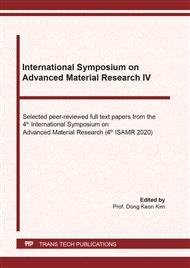[1]
ISO/ASTM 52900, « ISO/ASTM 52900:2015 », ISO. https://www.iso.org/cms/render/live/fr/sites/isoorg/contents/data/standard/06/96/69669.html.
DOI: 10.31030/2631641
Google Scholar
[2]
P. Muller, J.-Y. Hascoet, and P. Mognol, « Toolpaths for additive manufacturing of functionally graded materials (FGM) parts », Rapid Prototyp. J., 20(6), (2014), 511‑522,.
DOI: 10.1108/rpj-01-2013-0011
Google Scholar
[3]
J. Um, M. Rauch, J.-Y. Hascoët, and I. Stroud, « STEP-NC compliant process planning of additive manufacturing: remanufacturing », Int. J. Adv. Manuf. Technol., 88, (2016), 1215-1230,.
DOI: 10.1007/s00170-016-8791-1
Google Scholar
[4]
J. Kerninon, P. Mognol, J. Y. Hascoet, and C. Legonidec, « Effect of path strategies on metallic parts manufactured by additive process », Solid Freeform Fabrication Symposium, (2008), 352-361.
Google Scholar
[5]
S. W. Williams, F. Martina, A. C. Addison, J. Ding, G. Pardal, and P. Colegrove, « Wire + Arc Additive Manufacturing », Mater. Sci. Technol., 32(7), (2016), 641‑647,.
DOI: 10.1179/1743284715y.0000000073
Google Scholar
[6]
J.-Y. Hascoët, V. Querard, and M. Rauch, « Interests of 5 axis Tool Paths Generation for Wire Arc Additive Manufacturing of Aluminum Alloys », Journal of Machine Engineering, 13(3), (2018), 51-65.
Google Scholar
[7]
A. Queguineur, G. Rückert, F. Cortial, and J. Y. Hascoët, « Evaluation of wire arc additive manufacturing for large-sized components in naval applications », Weld. World, 62(2), (2018) 259‑266,.
DOI: 10.1007/s40194-017-0536-8
Google Scholar
[8]
W. Ya and K. Hamilton, « On-Demand Spare Parts for the Marine Industry with Directed Energy Deposition: Propeller Use Case », Industrializing Additive Manufacturing - Proceedings of Additive Manufacturing in Products and Applications - AMPA2017, (2018), 70‑81,.
DOI: 10.1007/978-3-319-66866-6_7
Google Scholar
[9]
« Ramsses Project: Ramsses Project ». https://www.ramsses-project.eu/.
Google Scholar
[10]
P. Muller, G. Rückert, and P. Vinot, « On the benefits of metallic additive manufacturing for propellers », Sixth International Symposium on Marine Propulsors, Rome (Italy), (2019), 1-8.
Google Scholar
[11]
G. Pechet, J.-Y. Hascoet, M. Rauch, G. Ruckert and A-S. Thorr, 2019. Manufacturing of a Hollow Propeller Blade with WAAM Process - From the Material Characterisation to the Achievement., Industry 4.0 summit – Shaping the Future of the Digital World, Manchester (UK), (2019), 1-6, ISBN: 978-0-367-42272-1.
DOI: 10.1201/9780367823085-28
Google Scholar


